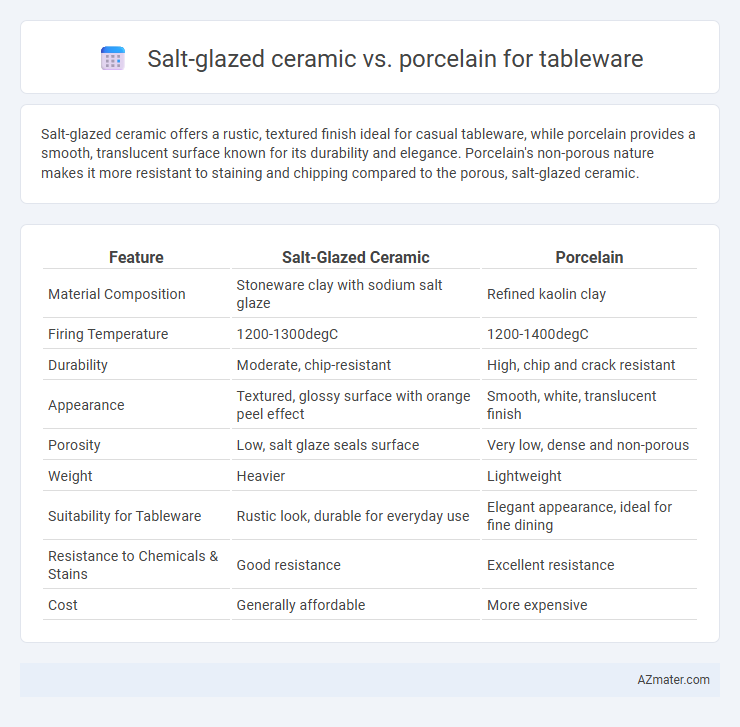Salt-glazed ceramic offers a rustic, textured finish ideal for casual tableware, while porcelain provides a smooth, translucent surface known for its durability and elegance. Porcelain's non-porous nature makes it more resistant to staining and chipping compared to the porous, salt-glazed ceramic.
Table of Comparison
| Feature | Salt-Glazed Ceramic | Porcelain |
|---|---|---|
| Material Composition | Stoneware clay with sodium salt glaze | Refined kaolin clay |
| Firing Temperature | 1200-1300degC | 1200-1400degC |
| Durability | Moderate, chip-resistant | High, chip and crack resistant |
| Appearance | Textured, glossy surface with orange peel effect | Smooth, white, translucent finish |
| Porosity | Low, salt glaze seals surface | Very low, dense and non-porous |
| Weight | Heavier | Lightweight |
| Suitability for Tableware | Rustic look, durable for everyday use | Elegant appearance, ideal for fine dining |
| Resistance to Chemicals & Stains | Good resistance | Excellent resistance |
| Cost | Generally affordable | More expensive |
Introduction to Salt-Glazed Ceramic and Porcelain
Salt-glazed ceramic is created by introducing salt into the kiln during high-temperature firing, producing a distinctive glossy, slightly textured surface with natural variations that enhance its rustic aesthetic. Porcelain, made from refined kaolin clay and fired at even higher temperatures, is renowned for its smooth, translucent appearance, strength, and durability, making it ideal for elegant, refined tableware. Both materials offer unique qualities: salt-glazed ceramics emphasize artisanal charm and robust textures, while porcelain delivers a sleek, delicate finish with superior hardness and chip resistance.
Historical Background and Origins
Salt-glazed ceramics originated in 15th-century Germany, where potters introduced salt into kiln fires, creating a distinctive glossy and textured surface prized for its durability and rustic appeal. Porcelain, first developed during China's Tang Dynasty around the 7th century and perfected in the Song Dynasty, features a smooth, white, and translucent body made from kaolin clay, valued for its elegance and strength in fine tableware. The historical use of salt glaze reflects traditional European craftsmanship, while porcelain represents centuries of refined Eastern ceramic artistry in tableware production.
Manufacturing Processes Compared
Salt-glazed ceramics undergo a process where salt is introduced into the kiln at high temperatures, creating a distinctive glassy, textured surface through a chemical reaction with the silica in the clay. Porcelain manufacturing involves refining kaolin clay and firing it at ultra-high temperatures (around 1,200-1,400degC), resulting in a dense, white, and translucent material with a smooth, non-porous surface. The key difference lies in the salt glazing technique that alters the ceramic's texture and appearance versus porcelain's emphasis on purity and vitrification for durability and elegance.
Aesthetic Differences: Texture and Finish
Salt-glazed ceramics feature a distinctive textured surface with a slightly glossy, irregular finish resulting from the salt vapor reacting with the clay during firing. Porcelain offers a smooth, glass-like finish that is typically more refined, translucent, and uniform in texture, highlighting its fine, dense composition. These aesthetic differences create contrasting tactile experiences and visual appeal, with salt-glazed tableware presenting a rustic, artisanal look, while porcelain exudes elegance and sophistication.
Durability and Strength for Everyday Use
Salt-glazed ceramics exhibit a durable, chip-resistant surface due to their vitrified salt glaze, making them suitable for everyday tableware that can withstand frequent handling. Porcelain offers exceptional strength and resistance to thermal shock owing to its dense, fine-grained structure and high firing temperature, ensuring longevity in daily use and dishwasher safety. Both materials provide robust options for durable tableware, with porcelain generally outperforming salt-glazed ceramics in terms of translucency and resistance to scratching.
Porosity and Water Absorption
Salt-glazed ceramic features a distinctive textured surface created by introducing salt during firing, resulting in moderate porosity and higher water absorption compared to porcelain. Porcelain, crafted from finely refined clay and fired at higher temperatures, exhibits extremely low porosity and minimal water absorption, making it more durable and resistant to liquid penetration. These properties influence hygiene and stain resistance, with porcelain preferred for tableware requiring enhanced water resistance and longevity.
Safety and Food Compatibility
Salt-glazed ceramic offers a durable, non-porous surface resistant to bacteria, making it safe for food use, though high firing temperatures are essential to prevent lead or cadmium leaching. Porcelain, known for its vitrified, non-porous body, provides superior food safety with minimal risk of chemical leaching and excellent resistance to staining and odor retention. Both materials meet FDA-approved standards when properly manufactured, but porcelain generally ensures higher consistency in food compatibility and dishwasher safety.
Maintenance and Cleaning Requirements
Salt-glazed ceramics feature a textured, slightly porous surface that demands gentle cleaning with non-abrasive sponges to preserve the glaze and prevent damage. Porcelain, known for its dense, non-porous structure, offers superior stain resistance and is dishwasher-safe, allowing for easy maintenance and thorough cleaning. While salt-glazed items require careful handwashing and avoidance of harsh detergents, porcelain's durability and smooth finish make it more practical for everyday tableware use.
Cost and Accessibility
Salt-glazed ceramics typically offer a more affordable option for tableware due to lower production costs and widespread availability of raw materials. Porcelain, characterized by its fine, dense composition and higher firing temperatures, generally commands higher prices and may be less accessible in some regions because of specialized manufacturing requirements. Consumers seeking budget-friendly, durable tableware often prefer salt-glazed ceramics, while those prioritizing elegance and translucency frequently choose porcelain despite its premium cost.
Choosing the Right Tableware: Which is Better?
Salt-glazed ceramic offers a distinctive textured finish and excellent durability, making it ideal for rustic or artisanal table settings, while porcelain provides a smooth, elegant surface with superior translucency and chip resistance, suited for formal dining. Porcelain is non-porous and often dishwasher and microwave safe, ensuring easy maintenance and hygiene, whereas salt-glazed ceramics may require more careful handling due to their porous nature and rough glaze. Choosing the right tableware depends on your style preference, durability needs, and usage frequency, with porcelain favored for everyday sophistication and salt-glazed ceramics preferred for unique, handcrafted appeal.

Infographic: Salt-glazed ceramic vs Porcelain for Tableware
 azmater.com
azmater.com